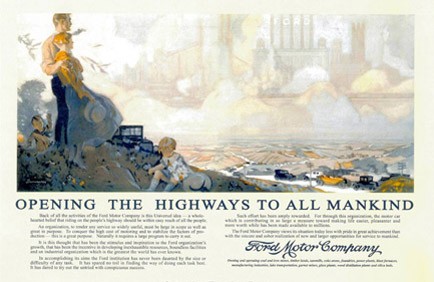
Financial Health
On January 24, 1925, Henry Ford took out an ad in the Saturday Evening Post outlining his vision for his eponymous company: to make safe and efficient transportation accessible to everyone – not just to the wealthy few. His dream of “opening the highways to all mankind” has continued to inspire our Company, especially over the last few years as we worked through the extraordinarily difficult economic environment. By staying focused on Ford Motor Company – on our core brands, on our overall financial health, on our commitments to all of our stakeholders – we are accelerating Henry Ford’s vision into the 21st century and making good on his promise.

Opening the Highways, Saturday Evening Post, January 24, 1925
As we look back on 2011, we can unequivocally state that we made it through one of the most challenging five-year periods in our history. We weathered the storm through a two-pronged strategy that took decisive actions for the short term while simultaneously developing a longer-range plan to return our Company to profitability. We’re proud to say this approach has been working. For 2011, we reported full-year pre-tax operating profit of $8.8 billion – our third year in a row of improved annual operating profits.
The most important thing we can do for ourselves and our stakeholders is profitably grow our Company by making the best cars and trucks in the world. Doing so doesn’t just boost our own Ford Motor Company finances; it simultaneously contributes to the much broader economic development of the communities in which we operate.
In addition, by zeroing in on producing more sustainable vehicles – both in how we manufacture them and how they operate on the roadways – we’re making significant contributions to the environmental sustainability of our planet. We have taken pollutants out of tailpipe exhaust and are pushing fuel efficiency to new heights. With the help of new technology, we are reducing – and perhaps may even one day eliminate – CO2 tailpipe emissions. And even as we sell a growing number of electric cars, we are developing alternative powertrains that will make cars affordable in every sense of the word – economically, socially and environmentally.
In 2006, led by then-incoming CEO Alan Mulally, we developed a road map, which we called the ONE Ford plan, to pull us out of an economic tailspin and drive us toward a fully globalized product strategy. The tenets of that plan included working together – across all aspects of our Company – to offer vehicles that could deliver on four critical pillars of the Ford brand: quality, green, safe and smart.
The steadfast progress we have made in the years since has transformed our Company from the inside out, and we believe our stakeholders are seeing us in a new light. Our customers, suppliers, investors, government leaders, union partners and our own employees know that we have made them a promise by committing to our ONE Ford plan. We have pledged to focus on the Ford brand and to deliver a family of vehicles that are leading in quality, fuel efficiency, safety, smart design and value. And we have promised to leverage our global resources to push ourselves even further for the benefit of all those associated with our business, both internally and externally.
We also continue to track and address emerging strategic sustainability issues, from global water availability to the sourcing of conflict minerals, which impact the development and manufacture of new products.
- 25 percent increase in sale of Ford’s U.S. small cars in 2011
- $16 billion invested in our U.S. operations – including $6.2 billion in U.S. plants – to design, engineer and produce more new and upgraded vehicles and components by 2015
Operating Profit
In 2011, we reported full-year pre-tax operating profit of $8.8 billion – our third year in a row of improved annual operating profits.
New Jobs in the U.S.
We committed to adding 12,000 hourly jobs in the U.S. by 2015 – 5,750 more than previously announced would be added by year-end 2012.




